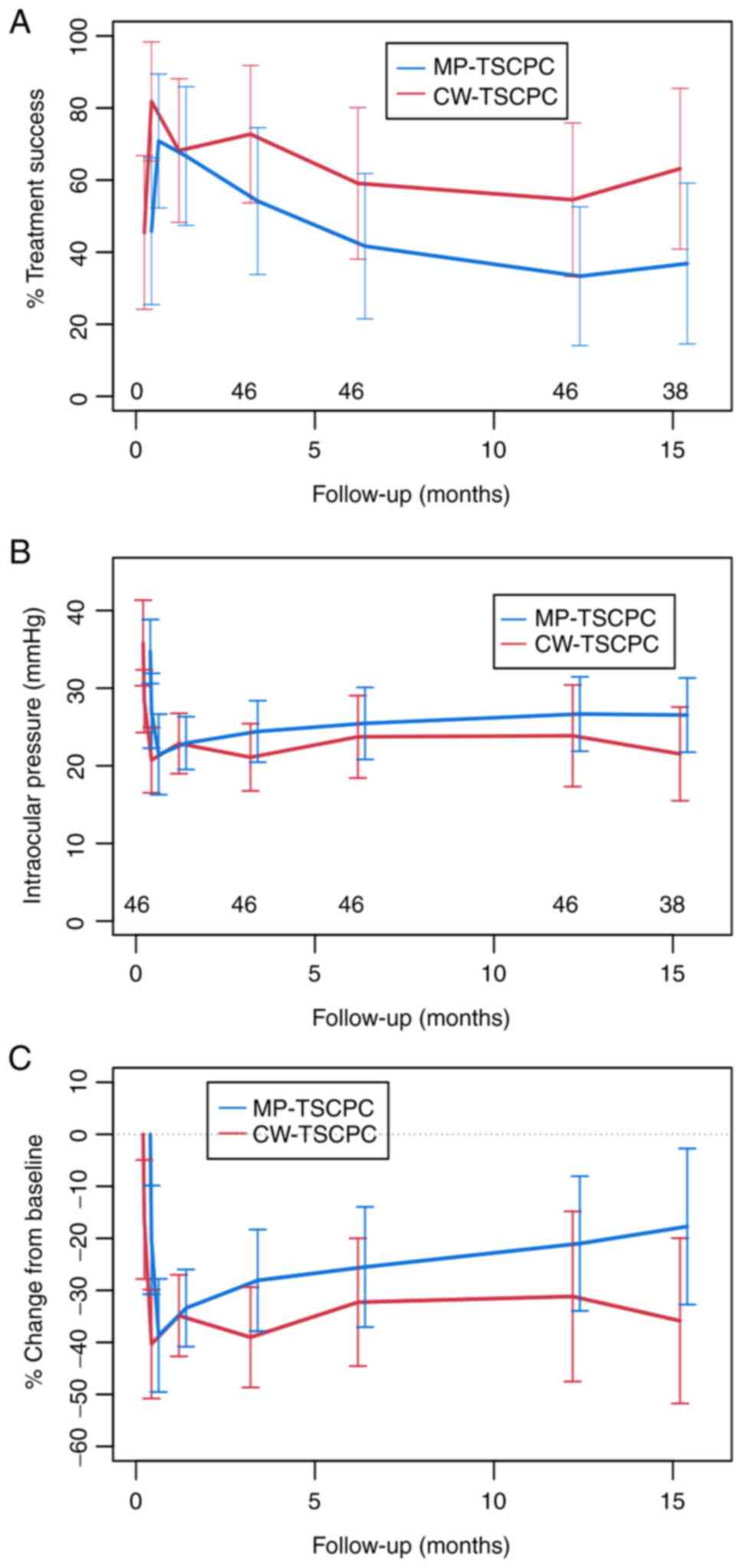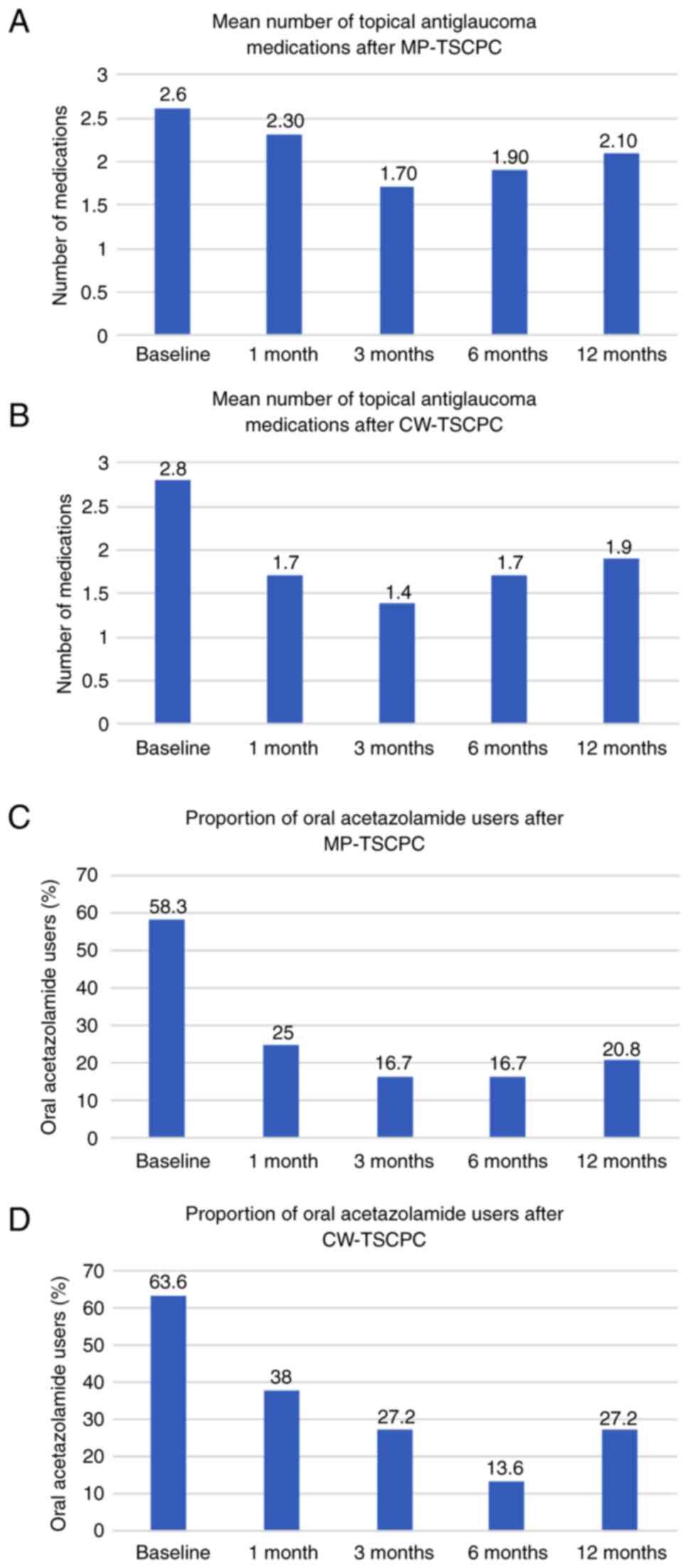|
1
|
Fong AW, Lee GA, O'Rourke P and Thomas R:
Management of neovascular glaucoma with transscleral
cyclophotocoagulation with diode laser alone versus combination
transscleral cyclophotocoagulation with diode laser and
intravitreal bevacizumab. Clin Exp Ophthalmol. 39:318–323.
2011.PubMed/NCBI View Article : Google Scholar
|
|
2
|
Sivak-Callcott JA, O'Day DM, Gass JD and
Tsai JC: Evidence-based recommendations for the diagnosis and
treatment of neovascular glaucoma. Ophthalmology. 108:1767–1777,
1800. 2001.PubMed/NCBI View Article : Google Scholar
|
|
3
|
Ndulue JK, Rahmatnejad K, Sanvicente C,
Wizov SS and Moster MR: Evolution of cyclophotocoagulation. J
Ophthalmic Vis Res. 13:55–61. 2018.PubMed/NCBI View Article : Google Scholar
|
|
4
|
Burgess SE, Silverman RH, Coleman DJ,
Yablonski ME, Lizzi FL, Driller J, Rosado A and Dennis PH Jr:
Treatment of glaucoma with high-intensity focused ultrasound.
Ophthalmology. 93:831–838. 1986.PubMed/NCBI View Article : Google Scholar
|
|
5
|
Aquino MC, Barton K, Tan AM, Sng C, Li X,
Loon SC and Chew PT: Micropulse versus continuous wave transscleral
diode cyclophotocoagulation in refractory glaucoma: A randomized
exploratory study. Clin Exp Ophthalmol. 43:40–46. 2015.PubMed/NCBI View Article : Google Scholar
|
|
6
|
Ma A, Yu SWY and Wong JKW: Micropulse
laser for the treatment of glaucoma: A literature review. Surv
Ophthalmol. 64:486–497. 2019.PubMed/NCBI View Article : Google Scholar
|
|
7
|
Pastor SA, Singh K, Lee DA, Juzych MS, Lin
SC, Netland PA and Nguyen NT: Cyclophotocoagulation: A report by
the American Academy of Ophthalmology. Ophthalmology.
108:2130–2138. 2001.PubMed/NCBI View Article : Google Scholar
|
|
8
|
Schlote T, Derse M, Rassmann K, Nicaeus T,
Dietz K and Thiel HJ: Efficacy and safety of contact transscleral
diode laser cyclophotocoagulation for advanced glaucoma. J
Glaucoma. 10:294–301. 2001.PubMed/NCBI View Article : Google Scholar
|
|
9
|
Amoozgar B, Phan EN, Lin SC and Han Y:
Update on ciliary body laser procedures. Curr Opin Ophthalmol.
28:181–186. 2017.PubMed/NCBI View Article : Google Scholar
|
|
10
|
Tan AM, Chockalingam M, Aquino MC, Lim ZI,
See JL and Chew PT: Micropulse transscleral diode laser
cyclophotocoagulation in the treatment of refractory glaucoma. Clin
Exp Ophthalmol. 38:266–272. 2010.PubMed/NCBI View Article : Google Scholar
|
|
11
|
Williams AL, Moster MR, Rahmatnejad K,
Resende AF, Horan T, Reynolds M, Yung E, Abramowitz B, Kuchar S and
Waisbourd M: Clinical efficacy and safety profile of micropulse
transscleral cyclophotocoagulation in refractory glaucoma. J
Glaucoma. 27:445–449. 2018.PubMed/NCBI View Article : Google Scholar
|
|
12
|
Stanca HT, Munteanu M, Jianu DC, Motoc
AGM, Tăbăcaru B, Stanca S, Ungureanu E, Boruga VM and Preda MA: New
perspectives in the use of laser diode transscleral
cyclophotocoagulation. A prospective single center observational
cohort study. Rom J Morphol Embryol. 59:869–872. 2018.PubMed/NCBI
|
|
13
|
Ramli N, Htoon HM, Ho CL, Aung T and
Perera S: Risk factors for hypotony after transscleral diode
cyclophotocoagulation. J Glaucoma. 21:169–173. 2012.PubMed/NCBI View Article : Google Scholar
|
|
14
|
Murphy CC, Burnett CA, Spry PG, Broadway
DC and Diamond JP: A two centre study of the dose-response relation
for transscleral diode laser cyclophotocoagulation in refractory
glaucoma. Br J Ophthalmol. 87:1252–1257. 2003.PubMed/NCBI View Article : Google Scholar
|
|
15
|
Iliev ME and Gerber S: Long-term outcome
of trans-scleral diode laser cyclophotocoagulation in refractory
glaucoma. Br J Ophthalmol. 91:1631–1635. 2007.PubMed/NCBI View Article : Google Scholar
|
|
16
|
Grueb M, Rohrbach JM, Bartz-Schmidt KU and
Schlote T: Transscleral diode laser cyclophotocoagulation as
primary and secondary surgical treatment in primary open-angle and
pseudoexfoliatve glaucoma. Long-term clinical outcomes. Graefes
Arch Clin Exp Ophthalmol. 244:1293–1299. 2006.PubMed/NCBI View Article : Google Scholar
|
|
17
|
Preda MA, Karancsi OL, Munteanu M and
Stanca HT: Clinical outcomes of micropulse transscleral
cyclophotocoagulation in refractory glaucoma-18 months follow-up.
Lasers Med Sci. 35:1487–1491. 2020.PubMed/NCBI View Article : Google Scholar
|
|
18
|
Zaarour K, Abdelmassih Y, Arej N, Cherfan
G, Tomey KF and Khoueir Z: Outcomes of micropulse transscleral
cyclophotocoagulation in uncontrolled glaucoma patients. J
Glaucoma. 28:270–275. 2019.PubMed/NCBI View Article : Google Scholar
|
|
19
|
Wong KYT, Aquino CM, Macasaet AM,
Suwandono ME, Chew PTK and Koh VTC: MP3 plus: A modified micropulse
transscleral cyclophototherapy technique for the treatment of
refractory glaucoma. J Glaucoma. 29:264–270. 2020.PubMed/NCBI View Article : Google Scholar
|
|
20
|
Souissi S, Baudouin C, Labbé A and Hamard
P: Micropulse transscleral cyclophotocoagulation using a standard
protocol in patients with refractory glaucoma naive of
cyclodestruction. Eur J Ophthalmol. 31:112–119. 2021.PubMed/NCBI View Article : Google Scholar
|
|
21
|
Singh K, Jain D and Veerwal V: Diode laser
cyclophotocoagulation in Indian eyes: Efficacy and safety. Int
Ophthalmol. 37:79–84. 2017.PubMed/NCBI View Article : Google Scholar
|
|
22
|
Nabili S and Kirkness CM: Trans-scleral
diode laser cyclophoto-coagulation in the treatment of diabetic
neovascular glaucoma. Eye (Lond). 18:352–356. 2004.PubMed/NCBI View Article : Google Scholar
|
|
23
|
Ishida K: Update on results and
complications of cyclophotocoagulation. Curr Opin Ophthalmol.
24:102–110. 2013.PubMed/NCBI View Article : Google Scholar
|
|
24
|
Ocakoglu O, Arslan OS and Kayiran A: Diode
laser transscleral cyclophotocoagulation for the treatment of
refractory glaucoma after penetrating keratoplasty. Curr Eye Res.
30:569–574. 2005.PubMed/NCBI View Article : Google Scholar
|
|
25
|
Vernon SA, Koppens JM, Menon GJ and Negi
AK: Diode laser cycloablation in adult glaucoma: Long-term results
of a standard protocol and review of current literature. Clin Exp
Ophthalmol. 34:411–420. 2006.PubMed/NCBI View Article : Google Scholar
|
|
26
|
Elhefney EM, Mokbel TH, Hagras SM, AlNagdy
AA, Ellayeh AA, Mohsen TA and Gaafar WM: Micropulsed diode laser
cyclophotocoagulation in recurrent pediatric glaucoma. Eur J
Ophthalmol. 30:1149–1155. 2020.PubMed/NCBI View Article : Google Scholar
|
|
27
|
Lee JH, Shi Y, Amoozgar B, Aderman C, De
Alba Campomanes A, Lin S and Han Y: Outcome of micropulse laser
transscleral cyclophotocoagulation on pediatric versus adult
glaucoma patients. J Glaucoma. 26:936–939. 2017.PubMed/NCBI View Article : Google Scholar
|
|
28
|
Walland MJ: Diode laser
cyclophotocoagulation: Longer term follow up of a standardized
treatment protocol. Clin Exp Ophthalmol. 28:263–267.
2000.PubMed/NCBI View Article : Google Scholar
|
















